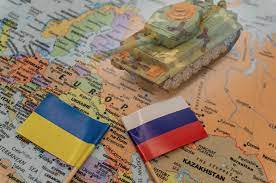The structure of global trade, still recovering from the effects of the Covid-19 pandemic, has been shaken by the onset of the conflict, further complicating the economic landscape. On February 24, 2022, Russia launched attacks on Ukrainian territory, including bombings in the capital Kiev. This event marked the beginning of a new phase in the conflict between the two countries. Since then, a series of developments have occurred, including meetings and resolutions at the United Nations (UN), imposition of sanctions by various countries and international organizations, threats of tactical nuclear weapons use, and the annexation of more regions of Ukraine by the Russian government. These events have heightened regional and global tensions, raising concerns about the humanitarian, economic, and geopolitical impact of the conflict. The situation continues to evolve rapidly, with the international community seeking diplomatic solutions to contain the escalation of violence and find a peaceful resolution to the conflict.

The impact of the Russia-Ukraine conflict extends beyond military aspects, also affecting the economic landscape and investments worldwide. The structure of international trade, which was recovering from the impacts of the Covid-19 pandemic, suffered another blow with the onset of the conflict, further complicating the economic scenario. Despite uncertainties, some industries have managed to maintain their stability, attracting the attention of vigilant investors. Sectors such as oil and agriculture, driven by robust production, remained stable and showed promising indicators for investments. Economist Marcello de Carvalho notes that “the Russian economy, as a major producer of oil, natural gas, and fertilizers, and the Ukrainian economy, responsible for a significant portion of the world’s grains, felt the impacts acutely, especially in the agricultural sector. Rising input costs, fertilizers, and fuel, combined with reduced grain supply, posed significant challenges.”
According to Carvalho, this dynamic has created both opportunities and challenges for economic agents. Those with reserves and expansion capacity were able to take advantage of rising grain prices. However, for those needing capitalization to expand their production, the scenario was more complex, especially in the face of high interest rates. Regarding investors, Carvalho emphasizes the importance of monitoring assets that have appreciated in the past two years. “Many assets have seen their values soar amid the war scenario,” he notes. “But it is crucial to understand that changes can occur, and asset allocation that has been successful so far may no longer be ideal. Investors must be prepared to take profits and adjust their strategies as necessary.”
Risk of Increased Tensions
While the conflict in Ukraine continues to shape geopolitical dynamics, the political proximity between China and Russia adds complexity to international relations. With China maintaining trade with Russia despite the ongoing conflict, an economic alliance between the two countries has strengthened, making them significant partners, at least economically. This partnership, which turns China into the main supplier of products to the Russians, concerns the United States, which views with apprehension the growing joint influence of China and Russia. However, given China’s significant role in the global economy, the impact of this alliance on tensions between the US and China is limited. Economic interdependence between the United States and China acts as a brake on hostilities, despite political differences.
As for the possibility of escalation of conflicts, both in Ukraine and the Middle East, the prospects are different. While conflicts in Ukraine seem more contained, with major countries already showing their support, conflicts in the Middle East appear to be increasing. The region remains a source of tensions, with conflicts intensifying and old disputes resurfacing. Thus, while conflicts in Ukraine may be under control, instability in the Middle East remains a constant concern, with the potential to trigger new episodes of violence and instability, both in the region and beyond. In this context, the world watches cautiously, aware of the challenges these conflicts pose to global peace and stability.
US Support
Despite the duration of the conflict, Russia maintains military superiority over Ukraine, which increasingly depends on international support to sustain itself. A possible withdrawal of US support, especially in the event of Trump’s victory, could significantly change the course of the conflict, making the Ukrainian situation even more difficult and facilitating Russian offensives. Therefore, the outcome of the conflict depends not only on local dynamics but also on international political decisions. “The United States is one of the largest military and economic powers in the world. If its support is reduced, Ukraine will have much more difficulty in keeping its troops supplied and financing the costs of war. This would facilitate Russian offensives,” evaluates Carvalho.
Global Trade
In an increasingly polarized and fragmented world, the viability of the EU-Mercosur agreement is questioned. “The increase in polarization makes the agreement less viable, but also more necessary. Although demands may be greater, economies need facilitation in negotiations to promote competitive and efficient environments, fundamental for global economic growth,” Carvalho points out. As for the multilateral approach to global trade, is it still valid in an increasingly polarized world? Despite the challenges, the answer is affirmative. “Despite facing moments of more intense polarization in the last century, multilateral agreements have proven essential. Although more difficult in times of polarization, multilateralism is increasingly necessary for a peaceful and efficient solution for all involved,” Carvalho emphasizes.
Resilience of the Russian Economy
The resilience of the Russian economy in the face of the war in Ukraine has been remarkable, even in the face of the initial impact of the crisis. In 2022, during the first year of the conflict, Russia’s GDP recorded a decline of 1.2%, according to official data. However, market analysts observed a scenario of recovery in 2023, with the Russian economy growing by 3.1%. This surprising performance suggests an ability to adapt and resilience, despite the adversities faced due to the conflict in the region.

